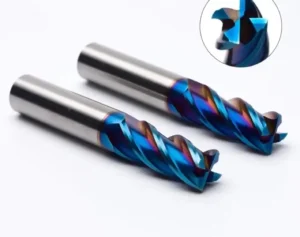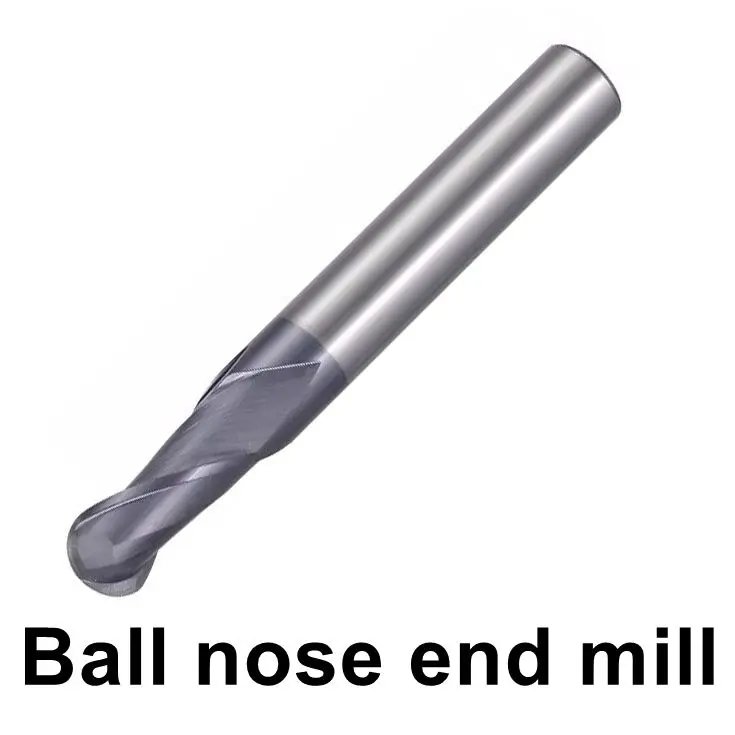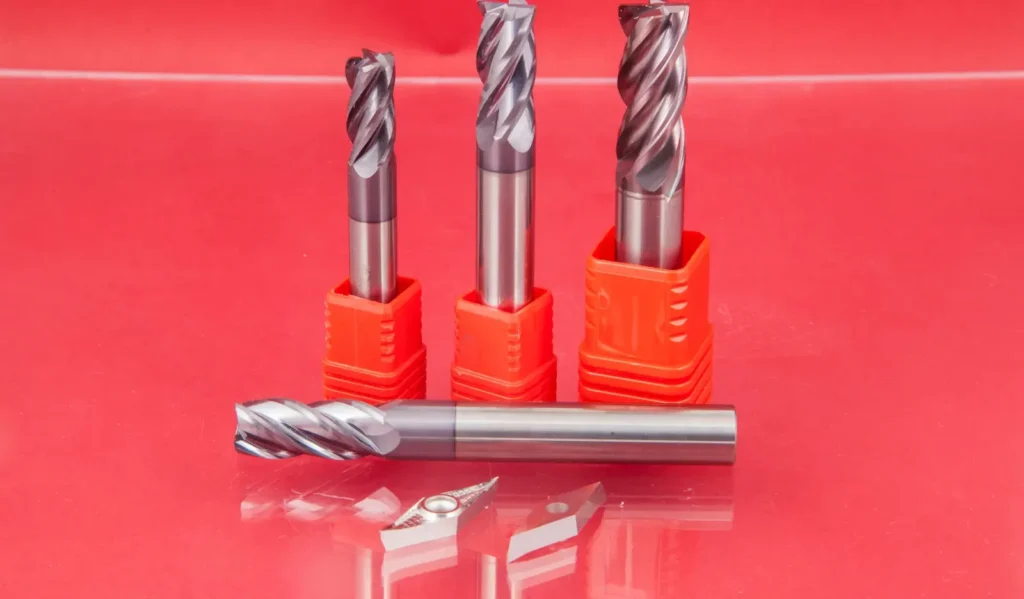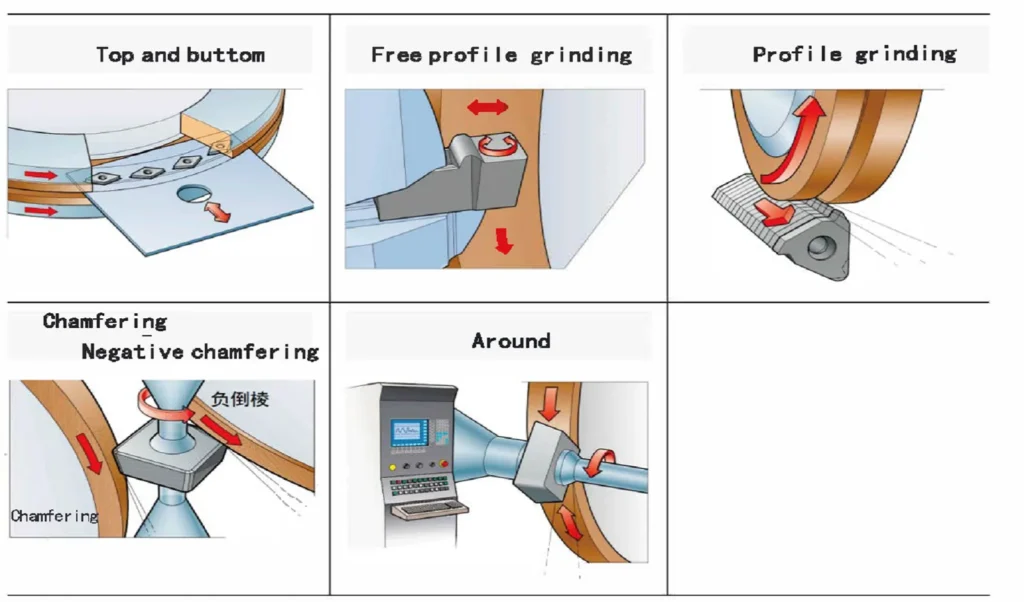在 CNC 加工和金屬製造的世界裡,選擇正確的切削刀具可以讓您的專案在品質、效率和成功率上完全不同。在討論中經常提到的兩種常用立铣刀是牛頭立铣刀和球頭立铣刀。雖然聽起來很相似,但這兩種刀具卻有截然不同的特性與應用。在本綜合指南中,我們將探討牛鼻立銑刀與球鼻立銑刀之間的差異,並介紹它們與平面立銑刀的比較。在本文完結時,您將會清楚瞭解哪一種刀具最適合您特定的加工需求。
瞭解立铣刀:基礎知識
在深入瞭解牛頭和球頭立铣刀的具體細節之前,讓我們先簡單回顧一下什麼是立铣刀及其在加工作業中的重要性。
顏色 立铣刀 是銑刀的一種,是用於銑床或加工中心的旋轉切削工具。這些多用途工具的設計目的,是在旋轉的同時沿著不同的軸向移動,從工件上去除材料。立铣刀有各種形狀、尺寸和配置,每種都針對特定類型的切削和材料進行了最佳化。
現在,讓我們專注於主要的比較:牛頭立銑刀 vs 球頭立銑刀。
牛鼻立铣刀:特性與應用
牛鼻立铣刀也稱為圓角立铣刀或半徑立铣刀,其特點在於其獨特的形狀。它們的特點是底部平坦,四角圓滑,有效地結合了平面銑刀和球形銑刀的元素。

牛鼻立铣刀的主要特性:
- 圓角平面切割面
- 轉角半徑小於刀具半徑
- 提供各種角半徑尺寸
牛鼻立铣刀的应用:
- 面對作業
- 內圓角開槽
- 平底塑形
- 混合平面與曲面
- 創建圓角和圓邊
牛鼻立铣刀的優勢:
- 與球頭立铣刀相比,材料去除速度更快
- 由於有更多材料支撐,因此切削刃更強
- 在平面上留下更平滑的表面處理
- 降低脆性材料崩裂的風險
- 粗加工和半精加工的理想選擇
球頭立铣刀:特性與應用
球頭立铣刀也稱為球面立铣刀或球頭立铣刀,其特點在於切削端為半球形(半球)。切削端的半徑等於刀具的半徑,形成連續的曲面。

球頭立铣刀的主要特點:
- 半球形切割端
- 半徑等於工具的半徑
- 連續彎曲刀刃
球頭立铣刀的應用:
- 3D 輪廓與雕刻
- 曲面精加工
- 在口袋和空腔中製造圓底
- 加工複雜的幾何形狀
- 在模具中製作細節
球頭立铣刀的優勢:
- 非常適合加工曲面和複雜的表面
- 在 3D 輪廓上提供一致的表面處理
- 允許平滑的刀具路徑轉換
- 精加工作業的理想選擇
- 減少二次加工的需求
牛頭銑刀 vs 球頭銑刀:主要差異
既然我們已經探討過這兩種類型的特性與應用,現在讓我們直接比較牛頭立铣刀與球頭立铣刀:
- 切割輪廓:
- 牛鼻子:表面平整,內角圓滑
- 球鼻:形成扇形或波浪形表面
- 材料移除率:
- 牛鼻子:由於平面切割區域較大,通常速度較快
- 球鼻:通常較慢,尤其是在平坦表面上
- 表面處理:
- 牛鼻:平坦表面的光滑度更高
- 球頭:弧形表面的光潔度更一致
- 強度與剛性:
- 牛鼻子:一般而言,由於切削邊緣的材料較多,因此強度較高
- 球頭:較容易偏斜,尤其是較長的刀具
- 多功能性:
- 牛鼻:適用於粗加工和精加工,尤其是在平面上
- 球頭:優於曲面精加工,但粗加工效率較低
- 刀具路徑編程:
- 牛鼻:圓角平面的簡化刀具路徑
- 球鼻:需要更複雜的刀具路徑,以獲得最佳的表面光潔度
球端銑刀 vs 平面銑刀:快速比較
為了提供更全面的瞭解,讓我們簡單比較一下球頭銑刀與平面銑刀:

平面立铣刀:
- 具有垂直於刀具軸線的平坦切削端
- 是製作方形肩、槽、平底口袋的理想選擇
- 在平面上提供更快的材料移除率
- 提供尖銳的內角
球頭研磨機:
- 具有半球形切割端
- 精於 3D 輪廓和曲面設計
- 內部不留尖角
- 針對複雜的幾何形狀提供更多功能
選擇適合您專案的立銑刀
在決定使用牛鼻立铣刀或球頭立铣刀(甚至是平面立铣刀)時,請考慮下列因素:
- 工件幾何:
- 扁平表面搭配圓角:牛鼻子
- 複雜的曲面:球鼻
- 帶銳角的平面:平面立铣刀
- 操作類型:
- 粗加工:牛鼻銑刀或平端面銑刀
- 曲線加工:球鼻
- 在平面上進行精加工:牛鼻銑刀或平面銑刀
- 材質:
- 硬度較高的材料可能會受益於牛鼻子更強的切削刃。
- 較軟的材料可使用任何類型的機床進行有效加工。
- 表面處理要求:
- 高品質的曲線表面處理:球頭
- 平滑的平面:牛鼻銑刀或平面銑刀
- 刀具壽命與剛性:
- 可延長刀具壽命及減少偏斜:牛鼻銑刀或平面銑刀
- 適用於可接受一定偏差的複雜幾何形狀:球頭
- 加工時間:
- 在平面上更快地去除材料:牛鼻銑刀或平面銑刀
- 高效的 3D 輪廓:球頭
總結
瞭解牛頭立铣刀與球頭立铣刀的差異,以及它們與平面立铣刀的比較,對於優化您的加工作業至關重要。每種立铣刀都有其優點和理想的應用。牛鼻立铣刀在材料去除率和表面光洁度之间实现了很好的平衡,尤其适用于带有圆角的平面。球頭立铣刀在 3D 輪廓加工和複雜曲面加工方面表現優異。平頭銑刀仍是在平面上製造尖角及快速材料移除的最佳選擇。
透過仔細考慮您的專案需求、工件幾何形狀以及預期結果,您可以選擇最適合的立銑刀類型。請記住,在許多複雜的加工專案中,可能需要結合不同類型的立銑刀,才能達到最佳效果。不要猶豫要不要試用不同的刀具,並請教經驗豐富的機械技師或刀具製造商,以調整您的選擇和加工策略。
立铣刀和球铣刀有什么区别?
主要差異:
切割輪廓:
立铣刀:製造平面或尖角
球磨機:製造曲面或扇形表面
材料移除率:
立铣刀:一般較快,尤其是在平面上
球磨機:通常速度較慢,但較適合弧形表面
精確度:
立铣刀:更精確的平面和銳利的特徵
球磨機:更適合光滑、連續的曲面
程式設計:
立铣刀:適用於平面的簡化刀具路徑
球磨機:更複雜的 3D 輪廓加工刀具路徑
強度:
立铣刀:由於有更多的材料支撐,因此一般較強
球磨機:較容易偏斜,尤其是較長的刀具
為何使用球頭研磨機?
球頭銑刀是加工作業中不可或缺的切削工具,其獨特的半球形狀在 3D 輪廓加工和曲面精加工方面表現優異。在模具製造中,球頭銑刀是創造平滑、複雜幾何形狀、製造圓角和圆角,以及在輪廓表面達到一致精加工效果的首選刀具。它們能將切削力分散到更大的區域,通常能減少刀具磨損和改善表面品質。儘管球頭銑刀在平面上的材料切削效率可能不如平頭銑刀或牛頭銑刀,但球頭銑刀在需要複雜的細部加工、平滑的刀具路徑,以及進入狹小空間或深腔的應用上,卻能大放異彩。球頭銑刀在處理複雜 3D 形狀以及在曲面上提供優異光潔度方面的多功能性,使其成為現代 CNC 加工不可或缺的工具,特別是對於要求高精度、美觀且具有複雜幾何形狀的零件的產業而言。
立铣刀的用途是什麼?
立铣刀是一種多用途切削工具,用於各種加工作業,特別是銑床和 CNC 加工中心。其設計目的在於結合旋轉切削與橫向移動來移除工件上的材料。立铣刀可用于多种任务,包括面铣、轮廓铣、槽切削、切入式切削以及开槽或开腔。立铣刀可在平面、轮廓和 3D 形状上执行粗加工和精加工操作。立铣刀有多種類型(如扁平、球頭和牛頭)和尺寸,每種類型都針對特定應用進行了最佳化。立铣刀能夠在多個方向進行切削 - 軸向、徑向和組合運動 - 使其成為航空航天、汽車、模具製造和一般製造業中生產複雜零件不可或缺的工具。立铣刀的多功能性使机械师能够创建精确的特征、实现所需的表面光洁度,并可加工从软塑料到硬化钢等各种材料,使其成为现代加工过程中的基本工具。
不能使用立铣刀作为钻头的原因是什么?
銑刀並非設計成鑽頭使用,因為其設計與預期功能有幾項重要差異。與鑽頭不同的是,立铣刀缺乏高效率起孔所需的專門刀尖幾何形狀,且未針對軸向切削力或垂直排屑進行最佳化。它們的刃口設計是針對橫向切削而非柱塞式切削,在用於鑽孔時可能會導致切屑堵塞和過熱。許多立銑刀都不是中心切削,因此很難啟動鑽孔,而且它們通常缺乏鑽頭的內部冷卻通道,這對於深孔應用非常重要。此外,立铣刀的切削速度与钻头不同,用于钻孔时可能会产生精度较低或较粗糙的孔。將立銑刀當作鑽頭使用,可能會造成孔的品質不佳、刀具壽命縮短、以及因切削力不匹配而可能造成刀具破損或偏斜。雖然在某些情況下,銑刀有時可以用來擴大現有的孔洞或製造淺孔,但一般而言,銑刀不適合或無法有效率地作為主要的鑽孔工具。



